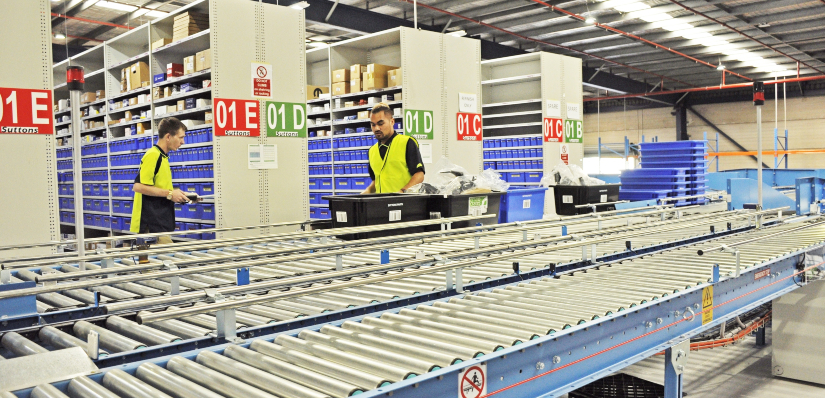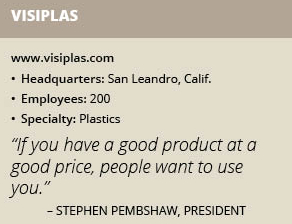
VISIPLAS
VISIPLAS was founded in Australia more than 20 years ago as a manufacturer of storage systems for small parts and in 2012 opened a U.S. facility. Today, the company also has a location in Germany that sells to the European market and a manufacturing facility in India.
VISIPLAS offers two categories of plastic products; small part storage systems and protectors for pallet storage racks.
For small parts storage, VISIPLAS generally is hired by large contractors although the ultimate customers are pharmaceutical, defense, aeronautical, automotive or “any entity that might need to store a large number of small parts,” President Stephen Pembshaw says. “When a car manufacturer, for example, is going to build a large distribution center, we deal with a contractor and work as a subcontractor.”
An automotive company might have as many as 300,000 items, about 20 percent of which are small items. “They need to have efficiently spaced storage,” Pembshaw says.
To help clients, the company also designs and builds steel shelving systems for its’ parts trays. That distinguishes VISIPLAS from other plastics manufacturers. “There are not many who can do the whole system,” Pembshaw says. “We can handle a larger number of very small parts than others can because they don’t have plastic integrated with steel [shelving]. These are very integrated, fitting closely together, and have very high storage density.”
VISIPLAS bins, both stacking and parts trays, are manufactured from virgin plastic. “Some places use recycled plastic,” Pembshaw says. “The problem is they tend to make a brittle product. For our product, we use polypropylene copolymer. It has good impact resistance. If you drop it on the ground, ours will have good impact resistance.”
For items that don’t comfortably fit into its bins VISIPLAS manufactures louvers and hooks. “It can be difficult to store items like timing belts and rubber hoses,” Pembshaw says.
The most difficult part of the customer process for storage systems is not the manufacturing. “Understanding the customer’s needs and optimizing for the customer,” Pembshaw says. “A lot of times customers have an idea but don’t know exactly what they are after.”
Really Low Cost
In 2012, VISIPLAS began manufacturing and selling pallet rack protectors. When forklifts or the cargo being carried by forklifts, inadvertently bump into uprights, the protectors prevent the bottom of the uprights from being damaged.
The company’s focus is on producing protectors for the intermediate – rather than the corner – uprights. “Those are relatively low risk and we try to produce a low-cost solution for the large number of low risk front uprights,” Pembshaw says. “Corner protectors might cost $100 to $200 each.” Intermediate protectors sold by VISIPLAS cost roughly $16 to $20 each.
“To keep that cost really low, we sell over the internet,” Pembshaw explains. “We also have direct sales through distributors or retailers.”
In November 2018, Visiplas introduced pallet rack deflectors, that are designed to reduce the effect of impacts against rear and front pallet racking uprights. The bright yellow pallet deflectors are designed for the very bottom of uprights. “The pallet rack deflectors were created to protect rear uprights from damage caused by forklift operators not entering the rack squarely with a load,” the company says. “Without the deflector, the pallet can strike the upright as it is pushed into the rack, damaging it.”
The deflector is composed of two interlocking parts that encircle the pallet rack post. Once it is secured, the deflector spins freely to absorb the impact of a pallet and also redirect its angle of entry to the proper place.
“During the developing and testing phase, we placed the unit in distribution centers across multiple industries,” Pembshaw says. “Consistently, facility managers reported that the device delivered up to 90 percent reduction in rear upright damage.”
Becoming Known
For distribution centers, the very top of the market has moved toward automation for storing and moving items. That can reduce costs for companies that handle very high volumes, Pembshaw says. “The trouble with automated systems is they work at a consistent level,” he says.” In other words, if there are spikes in business, an automated system could have trouble handling distribution. “When there is a manual system, you can hire extra people,” he says.
 As automated systems account for only a few percent of the market, Pembshaw doesn’t lose any sleep over them. “I think the biggest challenge faced by any sort of small company is just the fact of becoming known,” Pembshaw says. “Once people know we are there, we do reasonably well. Once we get a customer, they keep coming back. If you have a good product at a good price, people want to use you.”
As automated systems account for only a few percent of the market, Pembshaw doesn’t lose any sleep over them. “I think the biggest challenge faced by any sort of small company is just the fact of becoming known,” Pembshaw says. “Once people know we are there, we do reasonably well. Once we get a customer, they keep coming back. If you have a good product at a good price, people want to use you.”
To become known, VISIPLAS advertises on Google and promotes its products on its own website. Company representative also attend relevant trade shows.
Expanding Facilities
While Pembshaw doesn’t care for the word “lean” as in lean manufacturing, VISIPLAS is a proponent of reducing waste. Over the years its reduced waste in steel processing from 5 to 2 percent and plastic waste from 6 to less than 1 percent. That, in turn, has helped the bottom line. Not that it needs helping.
“The market is huge,” Pembshaw says. “All the automotive customers such as Chrysler, Ford, Toyota, Nissan, Hyundai. In retail, there is Amazon, Walmart and those sorts of guys. Every large company has some sort of distribution center, many requiring storage and picking of small parts.
Business is good. Our manufacturing operation was recently approved to build a new facility with an increase from 50,000 square feet to 200,000 square feet. The company is now searching for land. Once land is secured, construction is expected take about 12 months.
“It will dramatically increase the volume of production,” Pembshaw says. “The actual problem is that we have lots of ideas for new products but we don’t have room for the equipment that will manufacture them.”